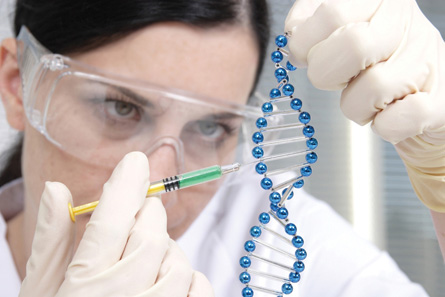Module 7
1. Module 7
1.17. Lesson 5
Module 7—Molecular Genetics: DNA, RNA, and Protein Synthesis
Lesson 5—Genetic Engineering
 Get Focused
Get Focused

© GeK/shutterstock
Research companies invest incredible amounts of money into equipment, staff, and research. Sometimes research leads to valuable discoveries and technologies. For example, research companies have valuable patents on specific plant and animal DNA sequences developed in their laboratories.
This valuable knowledge of DNA sequences has been used to transform DNA through genetic engineering. Genetic engineering, the process of changing a gene’s message by altering genetic material, is used to transfer a characteristic from one organism to another. For example, the silk gene from a spider that was introduced into the goat DNA resulted in silk in the goat’s milk. Genetic engineering has much controversy surrounding it and creates many questions.
genetic engineering: manipulation of genetic material to alter genes and blend plant, animal, and bacterial DNA
Who owns your DNA? Will you always own your DNA? Who has the right to alter your DNA? The Human Genome Project has now identified the entire sequence of human DNA. How will this important knowledge be used? Will human DNA sequences also be patented? Could genetic engineering lead to changes in the variation of the human population? Could this technology be used to create superhumans or superheros? Is this even a realistic, scientifically-based question?
For additional background on genetics and society, read from page 652 to “Biotechnology Products” on page 654 in your textbook.
Throughout this lesson, you will learn about the science behind genetic engineering, and then you will apply your knowledge to some of the questions above.
This lesson will address the following focusing questions:
- What roles do restriction enzymes and ligases play in changing the genome?
- What are some technologies involved in genetic engineering?
- What are the implications of genetic manipulation?
 Module 7: Lesson 5 Assignment
Module 7: Lesson 5 Assignment
The Module 7: Lesson 5 Assignment requires that you submit responses to the following:
- Part 1: Recreating the First Chimera
- Part 2: Bt Corn Research
- Part 3: Questions
Download a copy of the Module 7: Lesson 5 Assignment to your computer now. You will receive further instructions about how to complete this assignment later in the lesson.
You must decide what to do with the questions that are not marked by the teacher.
Remember that these questions provide you with the practice and feedback that you need to successfully complete this course. You should respond to all of the questions and place those answers in your course folder.
Remember, you also have the option of trying additional questions from the textbook for further practice. Consult with your teacher for the answers to these questions. The Key will also provide you with many Diploma Exam-style multiple-choice, numerical-response, and written-response questions that will be an excellent review of the module. Practising your responses to these types of questions is good preparation for the Diploma Exam.